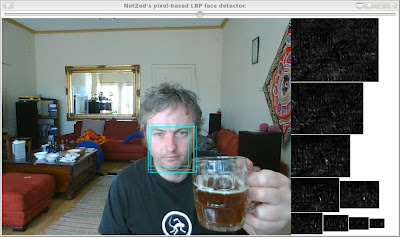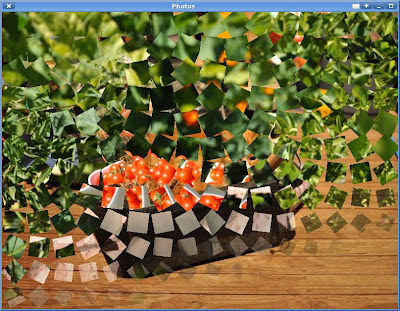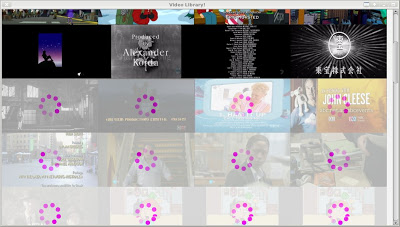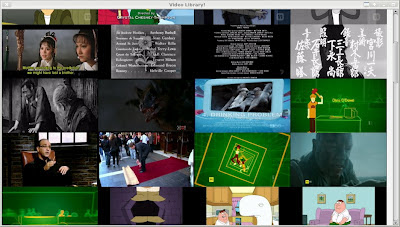About Me
Michael Zucchi
B.E. (Comp. Sys. Eng.)
also known as Zed
to his mates & enemies!
< notzed at gmail >
< fosstodon.org/@notzed >

FX'd ARM
I noticed Oracle have a developer preview for javafx on arm ... so I thought i'd give it a go.
My beagleboard isn't properly configured so I don't have EGL, but I did find an (obvious) option to enable software-only frame-buffer mode:
-Djavafx.platform=fb
I also turned off the embedded mode, otherwise the mouse didn't work:
-Dcom.sun.javafx.isEmbedded=false
Well it's definitely not speedy, but I did manage to get Ensemble to work, sort of. I'm not sure if it's so slow as it's crashed or just busy but i didn't get past the front page without losing patience (it's minutes) ... the mouse over animated tiles (e.g. 'Rotate Transition') manage about 1fps. The StopWatch is so slow it barely updates the screen, best I got was about 1fps out of that too.
BrickBreaker works (and whilst a bit slow does animate at multiple fps!), but I had trouble getting the beagleboard to output any screen resolution my old monitor liked ... so I stuck with the 1024x600 from the Oracle setup instructions, however at that size the paddle is off the screen.
Actually I was more interested in running it on the Kobo as that would be really interesting - but it fails to run there. Apart from complaining about the input devices it seems to crash opening fonts. I copied over libfontconfig from my beagleboard but that wasn't enough on it's own. I guess with a bit more work I could get it going (partially, i'm sure the E-Ink wont update properly) but I spent enough time just trying to get telnet re-enabled on firmware 2.0 on the kobo touch. The new firmware turns the radio on/off very fast so you have to be quick after starting the browser to telnet in and kill off nickel (otherwise, it just appears as though there is no network).
Actually now I have that going again (I've been using it to read books lately, and the 2.0 firmware was a big big improvement - even if i keep falling asleep 1 page in most nights and then lose my place as i flip a few pages with my hand as i fall asleep) I might revisit ReaderZ with the public JRE now available. Well, if I ever get the spare time ...
I noticed whilst using strace on the kobo that it's doing thousands of gettimeofday() calls, so it's obviously some sort of profiling build. Obviously software rendering is never going to be lightning, but I was using Java2D on the Kobo with adequate performance, so it should be fast enough for simpler scenes (using the embedded jre helped quite a bit there though).
Anyway, the news that JavaFX will be fully 'open sauced' by the end of the ?calendar? year is very good to hear.
But for now I have to delve into some mobile-to-server multi-client database sync stuff. Oh joy.
Linux desktop
I wrote this a week ago and wasn't sure about posting it, but since others seem to be sinking the boot in, why not as well ... Boy Sam Varghese has some 'GNOMEic issues' and doesn't pull too many punches.
So now BN is back to updates, I see Miguel is at it again - blaming others for things he had a hand in. He has arguably had more of an impact than any other individual on the "linux desktop", so we all know where the buck stops. About time he manned up and admitted he was a good part of the 'problem'.
However - there are a few big problems that Linux really has fucked up - sound is the prime example here. Removable and network disks could definitely be better too. Unfortunately by not fixing these things properly where they should be fixed - it has left a vacuum which has been filled by the 'desktop' application developers. And not surprisingly, taking a desktop approach to a system problem leads to the sort of rubbish we have infecting our systems these days. Witness the continual parade of shitty audio solutions; from esd onwards. Compare this to DVB-T, or video drivers: there's just no comparison.
Otherwise, the kernel together with GNU libc has done enough to isolate applications from internal changes, as one would expect from an operating system kernel. It's job is to isolate software from hardware, and both the api and abi is part of that isolation.
The poisonous idea?
So when it boils down to the argument seems to be that the "idea" of not worrying about binary compatibility is the root of the issue of the failure of GNU/Linux desktop's failing to gain traction.
It's a strange argument; the kernel is distributed in source form, so internal binary compatibility simply isn't an issue by design.
And It's no different from any other internal api for an application. So long as the external interfaces remain compatible (if that is important), it should be up to the application's designers to re-arrange the internals as they see fit. Forcing some arbitrary and meaningless internal-binary-compatibility layer there would just be a costly waste of time.
So this 'stance' is simply common engineering technique, it is nothing special at all.
Perhaps it's just a language or translation issue.
Nothing to fix anyway ...
Of course, the base of the argument is coming from the premise that there is something technically wrong with the GNU/Linux desktop to start with; a premise I believe is simply incorrect.
A decade ago we had a usable stable desktop, and by now I really cringe any time I have to use a lesser one - that's the one that's slow, cumbersome, out-dated, and feature-limited compared to what I'm used to day to day.
There is simply nothing wrong with it technically.
So it just comes down to popularity. There are other measures but that seems a popular one these days amongst the kids ...
And how soon some forget that the thugs at Microsoft gained their premier position simply through illegal activity - which has been successfully prosecuted several times around the world. There certainly seems to be circumstantial evidence that they are still using questionable practices to keep their position - for example by paying "ISV's" one way or another not to release software on competitive platforms. Or bribing educators to use their software as "training tools". Or other questionable contractual terms in government and business deals.
Developers Developers Developers
If there are issues with the lack of developer resources on modern 'desktop' solutions, it may be because most of them see it as a solved problem. Whilst it was fun at the time, i'm not terribly interested in that kinda shit anymore myself. And if we had even a fraction of the resources today available - it wouldn't really be much of an issue. But rather than leave a solved problem solved, those working on these systems seem hell-bent on either copying something else which keeps changing simply to justify repurchase (e.g. apple, microsoft), targeting new platforms which aren't all that relevant (tablets), or just making busy work for the sake of some ethereal goal they will never reach.
At this point, gtk+ should be stable and mature and stop changing, and it's up to the vendors who make money off this shit to supply the labour for it. Which is the current state afaik (although why Federico recently changed the default file requester location to 'recents' is beyond me - totally worthless feature i never used anyway). Qt was pretty much always there.
As for Miguel, his projects have all been basically 'copying microsoft', so excuse me if i'm not very interested: and i'm sure i'm not alone here. If i was i'd just use the real thing. The same for GNOME's Apple-filled fantasies. It might be different if we had nothing and were looking for inspiration, but we don't really need another weird version of FVWM ... yet again ... which is all they seem to end up being.
Most software written is in-house special-purpose software: this stuff doesn't need to 'integrate' with the desktop any further than cut and paste and a file requester (if that). Actually apart from a few simple desktop utilities, no software really needs to - for it to be valuable, usable software. And on a platform like GNU/Linux which has no unified `desktop', tying yourself to one or another is a bit of a risky approach. For such software the platform is already decided, and not a particularly important factor.
So the other tiny part of the software pile - 'isv's writing boxed software - will just go where the money is. And that's either where the volume is - which will depend on the operating system - or high value niche markets where the operating system is not an issue. GNU/Linux will only have a small part in the former for the foreseeable future, but has a place in the latter.
The Thick Object Detector
This was one of the first JavaFX things I played with - I was just hoooking up a web camera, but since that isn't too much on it's own I added a bit of code I'd been playing with at the time. An object detector.
It only works on systems with a Linux kernel.
Using pretty simple single-threaded Java code on the 640x480 input including generating the heat-maps, totals about 55ms per frame on my workstation. But the algorithm is parallelisable[sic] right down to the SIMD level, and because it's so simple it isn't even hard to do.
I'm not going to go into the training algorithm I'm using at the moment, but suffice to say it's very simple and very fast. Even though it's so brain-dead thick it still shows some promise - but still needs more work.
Source is over in MediaZ under fxperiments/FXDetectLBPP.
Beer time ...
JavaFX Slideshow 2
I had another poke at the slideshow idea, I wanted to play with tiled transitions, how to do them and to see how well they performed.
Works pretty well with the GPU driver, but a little chunky as an applet or with the cpu driver - but here's the Applet & Web Start launcher of a canned demo. I just included 4 shots of mine in the jar to simplify loading them for a demo. It looks much better if it can keep up with the frame-rate requirements.
It's only doing random effects so sometimes they're a bit bland (and i'm not sure if the webstart version implements all effects), but some quite nice transitions come up sometimes. The only 'trick' is breaking the image up into multiple image views - i.e. just texture mapping squares of image separately. Each ImageView is just then animated separately after that. I had to create my own Interpolator as the default ease-in one is a bit flaccid for my liking - although creating a spline in your head is a bit hit and miss ...
Source is in MediaZ under fxperiments/FXSlideZ.
Update: For various reasons I had a lot of time and the inclination to poke today, so i hacked in a few more things into the code (this stuff isn't in the applet).
First I added a 'start from centre' translation transition for the block animator which leads to some particularly pleasant transitions. Then I played with smaller rectangles - it changes the feel of the animations more than you would think, quite pretty, but it quickly starts to bog down the transition setup code as the tiles get smaller. About 20x20 is a reasonable compromise although I left it at 40x40. At 10x10 it takes a couple of seconds to build the transition tables.
Finally I worked out 'mask' based transitions and hacked them in as a random option. I tried a couple of variations, rendering to a canvas, just animating a shape (text), and changing geometry (a filled arc). That should cover about every possibility one might want. It's mostly just down to getting the blend modes and layout right and making sure the end of the animation covers the whole window.
Smooth video list
Another morning hack: seeing if i can use JavaFX to display a smoothly operating user interface whilst crap is going on in the background.
I was thinking of something like the PlayTV library interface and so on, where one should be able to smoothly scroll even if the video is loading or something is busy. It sort of works on the PS3 but I/O really gets in the way there.
So here's a very rough prototype of the same idea - except here every video visible is also playing at the proper speed (sans audio again) as well.
Again: without seeing it in motion it doesn't really do it justice. The shot above is after scrolling a bit, and it shows the 'busy spinner' until the video starts playing, and then the video slowly fades in to cover it.
And this is a bit later. Everything is smooth and responsive and keeps up fine (on a beastly workstation of a couple years vintage). It runs ok even with the CPU driver, but the GPU one is much better.
I used a FlowPane for the layout, so it dynamically readjusts should one resize the window. I then manually calculate which parts of the FlowPane are currently visible, and use that to initiate the transition to loading the video. The video just restarts if one moves away and comes back, although if you knew the seek was going to work that would be possible too (libavformat cannot seek on some files, and the fallback is unpleasant).
I used jjmpeg for the decoding again, although this time I hit a problem with the way i was sending frames to the display - writePixels has to be on the GUI thread too. Got around it with a frame copy ... they're only small frames. It also has some pretty major memory leak somewhere which shows up when scrolling about ... might need to poke around jjmpeg some to track that or it could be errors in the listener code - i'm not really familiar with JavaFX callback rules yet.
With these particular videos (transcoded tv stuff in mp4), it still runs pretty smooth even if I maximise the window ... that's 8x7 ... 56 concurrent decodes and display (actually 64 when it's between rows). Less than 500% cpu on a 6-core HT machine (ok, so it's basically maxed out, but it still copes). (ho hum: if only the hardware video decoding wasn't locked away from being accessed by the customers who bought it, as it is, who gives a shit about that).
MediaPlayer
I also tried MediaPlayer but it wasn't so hot. I'm not sure if you can get it to scale the image data host-side, but without it it's pretty bad. Whilst it plays (oh and with sound, which isn't so good! I muted that) it's a lot slower (only some frames shown) and the whole GUI chunks around all over the place when you scroll: i.e. exactly not what I was trying to achieve in the first place. The scaling quality is poor too.
I'm assuming 'MediaPlayer' must be created from the GUI thread here, it seems to be doing a good bit of synchronous stuff when it is.
I also seem to have some memory leaks here too, but whatever the reason they add up much much faster than with the jjmpeg stuff.
Source
I checked it into MediaZ/fxperiments/VideoLibrary, and it needs a checkout of jjmpeg to work (Netbeans).
Update: I wasn't going to post it but I also created a really shitty video of it in action: didn't realise my camera only does 720P@24, and the aliasing of the LCD pixels is very poor. I also downed the bitrate to make it smaller. But you can get an idea of how it runs anyway.
Pure woof!
So i finally got my order from focalprice delivered ... it got stuck in their system for a month (i think it got confused as to whether i had to reply to a query) and took a while to come through the mail. The padded bag was pretty knocked about and even torn under some tape, but somehow the contents arrived without being busted even inside some crushed boxes.
Got a new battery for my X61 thinkpad ... the previous one died about a year ago. It didn't exactly slide in cleanly and is a bit bendy, but I got it in eventually, I guess time will tell how well it works. At nearly 1/10th the price of the last one I got, I don't have a high bar for it to be considered worthwhile. So long as it doesn't burn the house down ...
I also grabbed an Ainol Novo 7 Elf ii 7" tablet - so I finally have a tablet of my own rather than a work thing. Seems quite well built, and the performance is pretty decent. The main downside so far is the video player isn't properly playing everything I have here. Video plays ok (actually very nicely, although not scaled in the default player) but for many files there's no sound. But other players play the sound (even jjplayer almost works on this thing) so it's either something to do with the hardware sound codec or some other strange bug. I even tried cyanogenmod but to no avail (although at least the firmware install process is simple). The Mele plays a lot more formats out of the box with their custom player. It's not like I need another screen to watch videos on (right now i have 5 in visible reach), but since it's there ... The screen needs to be fairly straight on too, particularly vertically in landscape (which makes portrait mode a little tricky as unless you're in the right spot one eye gets a darker view than the other), so I probably should've gone the few extra $ for the Aurora - i knew as soon as i ordered it that it wasn't worth the few $$ difference w/ the smaller flash too. But for the price it's really not that bad - i've just been spoilt so far with high-end devices. Should be handy for hacking on anyway. Oh and firefox is fairly decent now on android so I can use it for dunny-surfing ...
And lastly just for fun I got some 'ThinkBox' MD-18 mini speaker/mp3 player things. Mostly to give as presents. My sister had a 'music angel' which was kinda nifty and after poking around on-line I got the ThinkBox equivalent which also has an LCD display because I though the 3 button/no screen interface made it a bit hard to use ... It's basically a music player/fm radio/powered speaker with a built-in battery - it puts out enough volume to be usable as a computer speaker. It has sd-card slot, a usb slot for charging and line-in, and a usb-host for usb flash drives. Fairly solidly built (at least on the outside) and the firmware - whilst not wonderful - is passable.
It's almost worth it for the blurb on the back of the box, it's pure woof!
- New mini aluminuw vibration film loud speaker, which has caear alt and pure woof. The unique design makes tone performance perfect.
- Metallic,shell shows noble and fashionable,out of ordinary, with many colours,several solution;for your option.
- Several power supply manners including bactery,computer USB,adaptor DC-5V allow you to enjoy the charm of digital products at any time.
- Mini audio box with new concept integral stereo portable mobie music, connecting your MP3, CD, DVD, iPod, GPS, PSP, mobile phone, notebook computer and Micro SD/TF.
Well that blew my morning away ... I suppose i had better do some work now.
Simple infinite canvas
Just for a laff I coded up an 'infinite canvas' thing in JavaFX.
In the back of my mind I have the idea of making a JavaFX version of ImageZ ... but I'm also not sure I could be bothered going the whole hog. Although i could dump much of the code (although no more float support), there's still a lot of crap to deal with implementing basic features like undo.
This runs faster with the CPU renderer than with the GPU one. Drawing is about the same, but if you end up with a scene with many tiles created, the CPU pans faster ... which isn't what you'd expect. It can easily gobble up the whole heap if you create some gigantic image by zooming out a long way.
I didn't originally intend to, but since it was there I also copied the applet + webstarter to the site as well. The main reason is i've not yet had any such JavaFX applets work - but since this one did, there it is. One might need the very latest JRE for it to work (1.7.0-7). Update: I couldn't get it to work on my laptop, but that might be an old firefox - it ran fine from the jar.
I also started a new sub-project `fxperimentz' in MediaZ to chuck these experiments.
Update: Oh, i forgot to check the source in, it's there now.
The #1 Java feature I most desire ...
... is native complex numbers.
And I mean proper high-performance primitive complex numbers using standard operators and syntax. Not that horridly slow immutable object version in the apache maths libraries and being forced to use extremely messy function calls and manually having to de-infix every equation.
I had to write my own class of mutable complex numbers to get any sort of performance (and it is much much faster) - but it's even (a slight bit) uglier than the apache stuff to use. And on writing it yourself: thank you thank you cephes.
Right now coding complex arithmetic in C is far and away easier but the JNI required makes it a bit too painful for prototyping.
The only saving grace for me personally is that OpenCL C doesn't have them and if the algorithms make it that far I need to manually code the arithmetic up anyway.
Copyright (C) 2019 Michael Zucchi, All Rights Reserved.
Powered by gcc & me!





